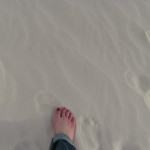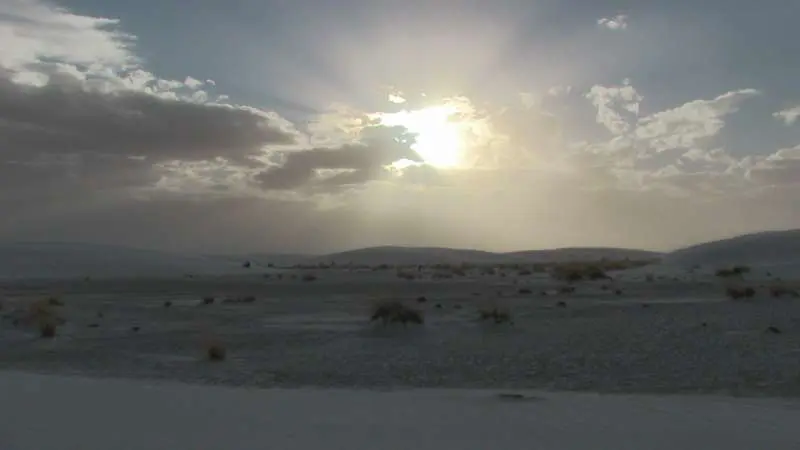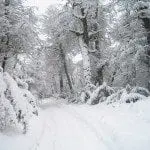
Battling the ferocious, bone-chilling desert wind of a February morning, I tightly gripped one handle of my sled while the rest of the sled flailed wildly in the wind. Looking out across the wide open field of pure white sand dunes, I knew that if I let go of that sled, it would be long gone in a matter of seconds. Finally, I managed to get a good hold of the other side of the sled and promptly sat down on top of it, ready to go sliding down a great white sand dune at White Sands National Monument near Alamogordo, New Mexico. It was truly a breath-taking experience – in every sense.
Sand dunes, like the ones I saw and sledded down at White Sands, are important for understanding the history of rock layers and the age of the earth. In geology, formations made by wind, like sand dunes are called Aeolian deposits (also spelled “Eolian”, pronounced “ee-oh-lee-uhn”). They are typically throught to be formed in desert environments, like we see at White Sands and in many other places around the world. People who want to believe in a very old earth and long periods of time (millions of years) will often point to rock layers that they say are Aeolian deposits, made in an “ancient desert”.

People who don’t want to accept the Biblical young-earth view (about six thousand years) and global flood will often point to Aeolian deposits, saying that you can’t have rock made by desert conditions forming during a flood, and that it had to have taken millions of years. However, many of the supposedly desert-deposited rocks are actually better explained as being made underwater. Some rock formations with cross-bedding are thought to be Aeolian (desert made) formations. Cross-bedding is when the thin layers of the rock are not all flat, one on top of another, but angled, sometimes making “Z” shapes. This cross-bedding could be explained by sand dunes in a desert, like I saw at White Sands, but sand dunes can also form underwater with the right currents making cross-bedding. Footprint fossils are also found preserved in deposits that are thought to be made in the desert, but footprints don’t last long in the desert and are also better explained by being preserved quickly in water-deposited rock.
One common example of a supposed Aeolian rock formation is the Coconino Sandstone layer, which can be seen in the Grand Canyon. A closer look at what the sand in the Coconino is actually made up of can shed some light on how it was formed. Sand, silt, and pebbles are all just names for grain sizes and don’t really have much to do with what minerals and chemicals make up the sand. The sand at White Sands is made of gypsum, very unlike your typical beach sand (read more about gypsum sand here). Some of the minerals found in the sand of the Coconino, including flaky mica and relatively soft dolomite, would not last long in a desert environment. Also, on closer examination, scientists have found that the sand grains of the Coconino are rough, unlike the well-rounded grains of desert deposited sand (study lead by Dr. John Whitmore). It looks like the Coconino is better explained by flood deposits rather than Aeolian desert dunes.
The dunes of White Sands are much more recent – they were made after the flood, when the world was recovering from such a dramatic catastrophe. Modern sand dunes are different from what we see in the Coconino Sandstone and other rock deposits from the flood. Don’t become daunted by the dunes and the explanations evolutionists try to give them by saying that they show long periods of time and changes in climate.
Copyright Sara J. Bruegel, 2016
- Brian Thomas, M.S. 2014. Do Sand-Dune Sandstones Disprove Noah’s Flood?. Acts & Facts. 43 (9). Institute for Creation Research. Last accessed 2-26-16 http://www.icr.org/article/8231
- Morris, J. 2010. The Coconino Sandstone: A Flood or a Desert? Acts & Facts. 39 (7): 15. Institute for Creation Research. Last accessed 2-26-15 http://www.icr.org/article/coconino-sandstone-flood-or-desert/
- Geology rain size reference chart. United States Geological Survey. Last accessed 2-26-16 http://pubs.usgs.gov/of/2003/of03-001/htmldocs/images/chart.pdf
- Dr. John Whitmore, Raymond Strom, Stephen Cheung, and Paul Garner. The Petrology of the Coconino Sandstone (Permian), Arizona, USA. December 10, 2014. Answers Research Journal. Last accessed 2-26-16. https://answersingenesis.org/geology/rock-layers/petrology-of-the-coconino-sandstone/
- “Coconino Sandstone—The Most Powerful Argument Against the Flood?” by Dr. John Whitmore on July 1, 2015; last featured November 1, 2015. Answers in Genesis. Last accessed 2-26-16 https://answersingenesis.org/geology/grand-canyon/coconino-sandstone-most-powerful-argument-against-flood/
- Morris, J. 2013. Slot Canyons, a Stunning Flood Formation. Acts & Facts. 42 (5): 15. Institute for Creation Research. Last Accessed 2-26-16. http://www.icr.org/article/slot-canyons-stunning-flood-formation/
- Tas Walker. “Shifting sands:How do we handle conflicts between geology and the Bible?”Creation 24(1):36–37. December 2001. Creation Ministries International. Last accessed 2-26-16. http://creation.com/shifting-sands





